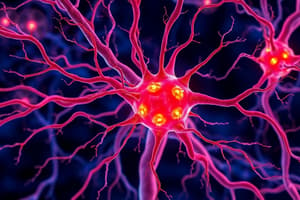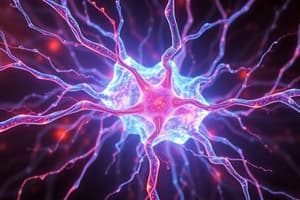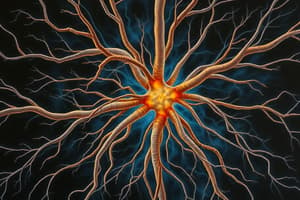Podcast
Questions and Answers
What are the two main parts of the nervous system, anatomically?
What are the two main parts of the nervous system, anatomically?
The central nervous system (CNS) and the peripheral nervous system (PNS)
What types of cells are found in nerve tissue?
What types of cells are found in nerve tissue?
- Neither A nor B
- Both A and B (correct)
- Neurons
- Supporting cells
From which embryonic germ layer does the nervous system develop?
From which embryonic germ layer does the nervous system develop?
- Mesoderm
- Endoderm
- Ectoderm (correct)
Which of the following cells give rise to the entire central nervous system?
Which of the following cells give rise to the entire central nervous system?
Which of the following cells contribute to the formation of the peripheral nervous system?
Which of the following cells contribute to the formation of the peripheral nervous system?
Which part of the neuron contains the nucleus and most of the cell's organelles?
Which part of the neuron contains the nucleus and most of the cell's organelles?
Which part of the neuron is specialized to receive stimuli from other neurons?
Which part of the neuron is specialized to receive stimuli from other neurons?
Which part of the neuron is specialized to transmit nerve impulses to other cells?
Which part of the neuron is specialized to transmit nerve impulses to other cells?
All neurons have the same size and shape.
All neurons have the same size and shape.
Which of the following is NOT a way to classify neurons?
Which of the following is NOT a way to classify neurons?
Which division of the nervous system receives sensory input from receptors throughout the body?
Which division of the nervous system receives sensory input from receptors throughout the body?
Which division of the nervous system receives sensory input from internal organs and cardiovascular structures?
Which division of the nervous system receives sensory input from internal organs and cardiovascular structures?
Which division of the nervous system sends motor output to skeletal muscles?
Which division of the nervous system sends motor output to skeletal muscles?
Which division of the nervous system controls involuntary functions, such as heart rate and digestion?
Which division of the nervous system controls involuntary functions, such as heart rate and digestion?
Which part of the autonomic nervous system is responsible for "fight or flight" responses?
Which part of the autonomic nervous system is responsible for "fight or flight" responses?
Which part of the autonomic nervous system is responsible for "rest and digest" functions?
Which part of the autonomic nervous system is responsible for "rest and digest" functions?
What are the functions of interneurons?
What are the functions of interneurons?
Which type of neuron has one axon and two or more dendrites?
Which type of neuron has one axon and two or more dendrites?
Which type of neuron has one dendrite and one axon?
Which type of neuron has one dendrite and one axon?
Which type of neuron has a single process that bifurcates close to the cell body?
Which type of neuron has a single process that bifurcates close to the cell body?
Which type of neuron has many dendrites but no true axon?
Which type of neuron has many dendrites but no true axon?
What is the function of the cell body of a neuron?
What is the function of the cell body of a neuron?
Dendrites are typically longer than axons.
Dendrites are typically longer than axons.
Dendritic spines are the sites of signal reception and processing.
Dendritic spines are the sites of signal reception and processing.
Axons originate from a pyramid-shaped region of the perikaryon called the axon hillock.
Axons originate from a pyramid-shaped region of the perikaryon called the axon hillock.
What is the name of the process that transports molecules from the cell body to the axon terminals?
What is the name of the process that transports molecules from the cell body to the axon terminals?
What is the name of the electrical signal that travels along the axon?
What is the name of the electrical signal that travels along the axon?
What type of ion channels are responsible for the depolarization phase of the action potential?
What type of ion channels are responsible for the depolarization phase of the action potential?
Neurotransmitters are usually small molecules that bind to specific receptor proteins.
Neurotransmitters are usually small molecules that bind to specific receptor proteins.
What is the name of the space between the presynaptic and postsynaptic membranes?
What is the name of the space between the presynaptic and postsynaptic membranes?
Synaptic transmission can occur electrically or chemically.
Synaptic transmission can occur electrically or chemically.
The presynaptic axon terminal contains synaptic vesicles that store neurotransmitters.
The presynaptic axon terminal contains synaptic vesicles that store neurotransmitters.
The postsynaptic membrane contains receptors that bind neurotransmitters.
The postsynaptic membrane contains receptors that bind neurotransmitters.
What is the name of the process by which neurotransmitters are released from the presynaptic neuron?
What is the name of the process by which neurotransmitters are released from the presynaptic neuron?
What type of effect does an excitatory neurotransmitter have on the postsynaptic neuron?
What type of effect does an excitatory neurotransmitter have on the postsynaptic neuron?
What type of effect does an inhibitory neurotransmitter have on the postsynaptic neuron?
What type of effect does an inhibitory neurotransmitter have on the postsynaptic neuron?
The response of a postsynaptic neuron is determined by the summation of activity at all synapses on that cell.
The response of a postsynaptic neuron is determined by the summation of activity at all synapses on that cell.
Glial cells are more numerous than neurons in the mammalian brain.
Glial cells are more numerous than neurons in the mammalian brain.
What are the four major types of glial cells in the CNS?
What are the four major types of glial cells in the CNS?
Which type of glial cell is responsible for producing myelin in the CNS?
Which type of glial cell is responsible for producing myelin in the CNS?
Which type of glial cell provides structural and metabolic support to neurons?
Which type of glial cell provides structural and metabolic support to neurons?
Which type of glial cell lines the ventricles and central canal of the CNS?
Which type of glial cell lines the ventricles and central canal of the CNS?
Which type of glial cell is responsible for immune defense in the CNS?
Which type of glial cell is responsible for immune defense in the CNS?
Schwann cells are found in the CNS.
Schwann cells are found in the CNS.
Satellite cells are found in the PNS, surrounding neurons in ganglia.
Satellite cells are found in the PNS, surrounding neurons in ganglia.
Astrocytes are the most abundant type of glial cell in the CNS.
Astrocytes are the most abundant type of glial cell in the CNS.
What is the main component of white matter in the CNS?
What is the main component of white matter in the CNS?
What is the main component of gray matter in the CNS?
What is the main component of gray matter in the CNS?
The spinal cord is covered by three meningeal layers.
The spinal cord is covered by three meningeal layers.
Which of the following is NOT a function of the meninges?
Which of the following is NOT a function of the meninges?
The subarachnoid space is filled with cerebrospinal fluid (CSF).
The subarachnoid space is filled with cerebrospinal fluid (CSF).
The pia mater is the outermost meningeal layer.
The pia mater is the outermost meningeal layer.
The dura mater is the toughest meningeal layer.
The dura mater is the toughest meningeal layer.
The arachnoid mater is a weblike layer that contains the subarachnoid space.
The arachnoid mater is a weblike layer that contains the subarachnoid space.
The blood-brain barrier is formed by the pia mater.
The blood-brain barrier is formed by the pia mater.
What is the function of the choroid plexus?
What is the function of the choroid plexus?
Myelin is a lipid-rich substance that insulates axons.
Myelin is a lipid-rich substance that insulates axons.
Myelinated axons are typically smaller in diameter than unmyelinated axons.
Myelinated axons are typically smaller in diameter than unmyelinated axons.
What type of glial cell is responsible for myelinating axons in the PNS?
What type of glial cell is responsible for myelinating axons in the PNS?
One Schwann cell can myelinate multiple axons in the PNS.
One Schwann cell can myelinate multiple axons in the PNS.
The myelin sheath is continuous along the entire length of an axon.
The myelin sheath is continuous along the entire length of an axon.
What type of neurons are typically unmyelinated?
What type of neurons are typically unmyelinated?
Ganglia are clusters of neuronal cell bodies in the CNS.
Ganglia are clusters of neuronal cell bodies in the CNS.
Sensory ganglia are associated with the dorsal roots of spinal nerves.
Sensory ganglia are associated with the dorsal roots of spinal nerves.
Autonomic ganglia are associated with the ventral roots of spinal nerves.
Autonomic ganglia are associated with the ventral roots of spinal nerves.
Autonomic ganglia are typically smaller than sensory ganglia.
Autonomic ganglia are typically smaller than sensory ganglia.
Autonomic nerves use a two-neuron circuit.
Autonomic nerves use a two-neuron circuit.
What is the neurotransmitter released by preganglionic neurons in both the sympathetic and parasympathetic nervous systems?
What is the neurotransmitter released by preganglionic neurons in both the sympathetic and parasympathetic nervous systems?
Sympathetic ganglia are located close to the CNS, while parasympathetic ganglia are located near the target organs.
Sympathetic ganglia are located close to the CNS, while parasympathetic ganglia are located near the target organs.
Neuronal regeneration is more efficient in the CNS than in the PNS.
Neuronal regeneration is more efficient in the CNS than in the PNS.
Multiple sclerosis is a neurodegenerative disease that affects the myelin sheath.
Multiple sclerosis is a neurodegenerative disease that affects the myelin sheath.
The axons of motor neurons regenerate from their cut ends after a delay.
The axons of motor neurons regenerate from their cut ends after a delay.
Flashcards
Central Nervous System (CNS)
Central Nervous System (CNS)
The brain and spinal cord, located in the cranial and spinal cavities respectively; receives sensory inputs & sends motor outputs via nerves.
Peripheral Nervous System (PNS)
Peripheral Nervous System (PNS)
Nerves that connect the CNS to the rest of the body, including cranial, spinal, and peripheral nerves.
Neuron
Neuron
The functional unit of the nervous system; transmits nerve impulses.
Neuroglia/Glial Cells
Neuroglia/Glial Cells
Signup and view all the flashcards
Cell Body (Perikaryon/Soma)
Cell Body (Perikaryon/Soma)
Signup and view all the flashcards
Dendrites
Dendrites
Signup and view all the flashcards
Axon
Axon
Signup and view all the flashcards
Sensory (Afferent) Division
Sensory (Afferent) Division
Signup and view all the flashcards
Motor (Efferent) Division
Motor (Efferent) Division
Signup and view all the flashcards
Autonomic Nervous System(ANS)
Autonomic Nervous System(ANS)
Signup and view all the flashcards
Multipolar Neuron
Multipolar Neuron
Signup and view all the flashcards
Bipolar Neuron
Bipolar Neuron
Signup and view all the flashcards
Unipolar/Pseudounipolar Neuron
Unipolar/Pseudounipolar Neuron
Signup and view all the flashcards
Anaxonic Neuron
Anaxonic Neuron
Signup and view all the flashcards
Study Notes
Nervous Tissue Summary
- Anatomically, the nervous system is divided into the central nervous system (CNS) and the peripheral nervous system (PNS).
- The CNS includes the brain and spinal cord.
- The PNS includes cranial, spinal, and peripheral nerves.
- Nerve tissue is composed of neurons and supporting cells (neuroglial cells or glia).
- Neurons are the functional units of the nervous system.
- Glial cells are nonconducting cells that support neurons.
Development of Nerve Tissue
- The nervous system develops from ectoderm, beginning in the third week of embryonic development.
- Cells of the neural tube develop into the entire CNS, including neurons and most glial cells.
- Cells derived from the neural crest form components of the PNS.
Neurons
- The neuron is the functional unit of the CNS and PNS.
- A neuron typically has three main parts: cell body (perikaryon/soma), dendrites, and axon.
- The cell body contains the nucleus and most organelles.
- Dendrites receive stimuli from other neurons.
- The axon transmits impulses to other cells (neurons, muscles, or glands).
- Neurons vary in size and shape.
- Neurons can be classified functionally as sensory (afferent) or motor (efferent), and further categorized as somatic or visceral.
Sensory Division
- The sensory division receives stimuli from receptors.
- Somatic sensory input is perceived consciously (e.g., from eyes, ears, skin).
- Visceral sensory input is not perceived consciously (e.g., internal organs).
Motor Division
- The motor division sends impulses to effector organs.
- Somatic motor output is controlled consciously/voluntarily (skeletal muscles).
- Autonomic motor output is not consciously controlled (heart, glands).
- The autonomic nervous system (ANS) has two neurons (preganglionic and postganglionic).
Glial Cells
- Glial cells support neuronal survival and activities.
- They are more numerous than neurons in the brain.
- Four major types of glial cells are oligodendrocytes, astrocytes, ependymal cells, and microglia.
Synaptic Communication
- Synapses are the sites where nerve impulses are transmitted from one neuron to another (or to another cell type).
- Chemical synapses are the most common type, involving neurotransmitters released by the presynaptic neuron, binding to receptors on the postsynaptic neuron, and opening ion channels..
- Neurotransmitters can cause either excitatory or inhibitory responses in the postsynaptic neuron.
Nervous System Divisions
- The ANS has two principal divisions: parasympathetic and sympathetic.
- The parasympathetic division is responsible for maintaining homeostasis.
- The sympathetic division controls the body's responses during emergencies and excitement.
Studying That Suits You
Use AI to generate personalized quizzes and flashcards to suit your learning preferences.




